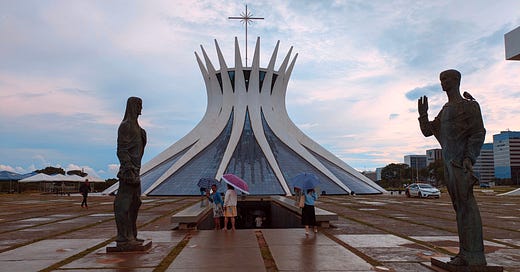Everyday is buffet day in Brazil
And, if you've never lay cuddling the floor of a public toilet, have you ever really travelled?
A strange thing happened today: I was walking down the street in Maceió, arm-in-arm with Dave, when I looked up and realised there was a gun pointing right at me.
We'd just left a café that we'd spent too much time in and were in the middle of a satisfying bitch about our shared enemy there, a particularly annoying woman who had been encroaching on my space. Dave was mid-flow and I was enjoying the debrief, so my instincts were to not interrupt him and simply steer him out the way of the man walking slowly towards us with a pistol, just a couple of metres in front. After a beat, I said, “Oh, mind out, man with a gun,” by way of explaining my side-step in the same way I might have said, “Oh, mind out the way of that dog turd,” and we simply carried on crossing the road to get to the beach.
I should explain that the man holding the gun was a police officer, and I quickly realised that he wasn't actually pointing the gun at me but at another man standing in-between us, who thankfully stopped running very quickly and put his hands on his head in surrender. We watched calmly on as the police officer caught up with him, bundled him into the actual boot of a car (really) and drove off. And then we carried on bitching about the woman in the café.
Thinking about it later, my calm reaction seems particularly strange given that: a) I have never had a gun pointed at me before, and b) we don't very often tend to see guns in real life back home – unlike in a lot of countries, British police officers don't tend to carry them on the street. Maybe I've become desensitised from watching too many crime dramas, but I wasn't remotely fazed by the thing.
How privileged am I, to be a white person walking through the streets of Brazil, to see a gun in front of my face and instinctively know that it's not for me – to not feel scared? And how lucky, I suppose, that the assailant clearly didn't have a weapon of his own, or seize his moment to use two tourists as a protective barrier and keep on running (fool!) – if he had, my final conversation with Dave could have been about a rude woman in a café taking up too much space.
As we hurtle through December already (where have the past two weeks gone?) and the bright lights of advent and all things Christmas surround us here in the land of overindulgence, I need to talk to you about one of the most important parts of Brazilian culture: the pay-per-kilo buffet.
I've already droned on about the brilliance of the humble menu del día, a lunchtime staple in Peru and several other Spanish-speaking countries on this continent. Those simple meals were a reliably cheap and filling way to fuel ourselves whether in a tiny mountainside village or a thronging city metropolis. They were stodgy, rarely gourmet, but I miss them dearly.
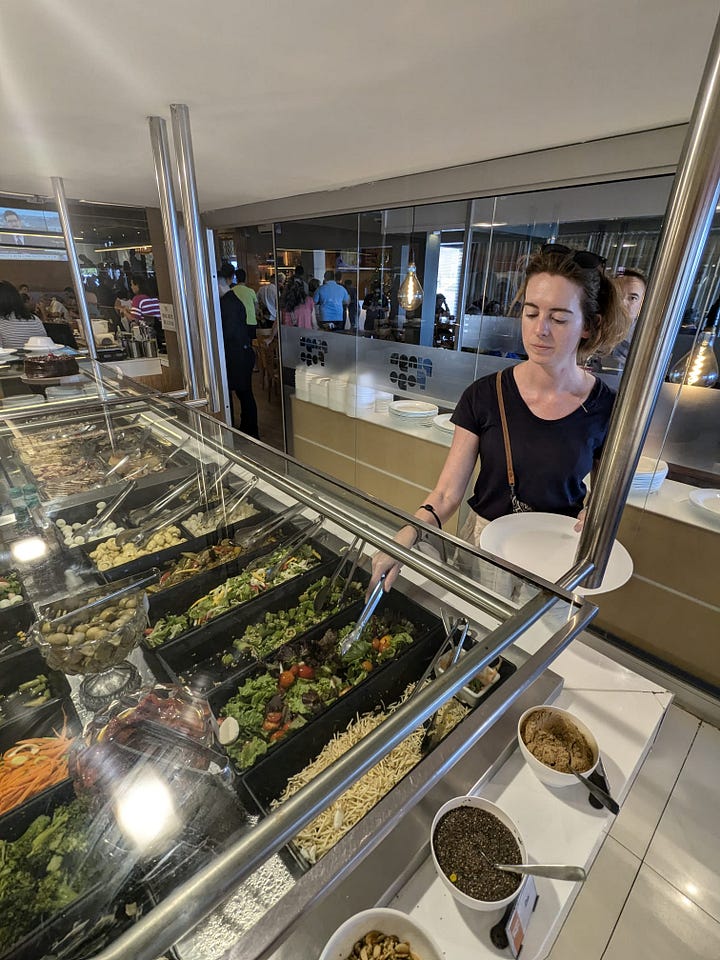

Brazil takes a predictably more indulgent approach to meal times. Just like the menu del día, you can expect to find a traditional lunchtime buffet on pretty much any street corner in the country. But where the menu del día restaurant might just be a couple of small communal tables, the Brazilian buffet hall is often huge, polished, with accompanying live music and populated by everyone from suited office workers to bus drivers, families to couples on dates.
The system is solid: as you walk in the door you're handed a slip of paper, or a token with a QR code at some of the shinier establishments. Then you take a plate and pile it as high as you like from the constantly refreshing counters of fish and meat stews, breads and salads, pasta, risotto and (often) an open churrasco (barbeque) grill. If it’s a classy place, or even a simple place with heaps of self-respect, the dishes will be in large earthenware pots sitting over a permanent flame to keep the pastas and meat casseroles bubbling hot. Always, there will be a SWAT-team of hairnetted ladies seamlessly monitoring and refreshing the dishes around you.
Then you take your plate to the balança (scale), where an attendant informs you of your greed levels and marks it down on the paper slip you're carrying. The cost of your plate is calculated by the gram, or you can opt to pay a set price for the all-you-can eat option (and it's usually obvious who fits into this category by glancing around the room). Sometimes there will be a cap (say 500g, or $60 reais’ worth of food) and if you've already hit it you are free to go back for refills. Dave is proud to have exceeded that limit on almost every occasion.
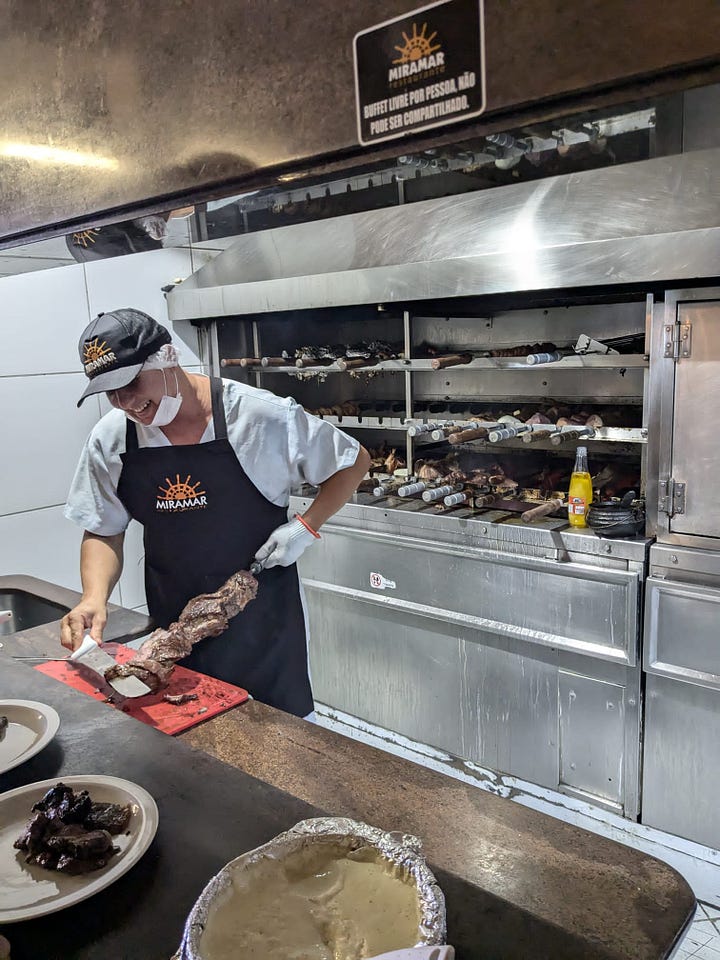
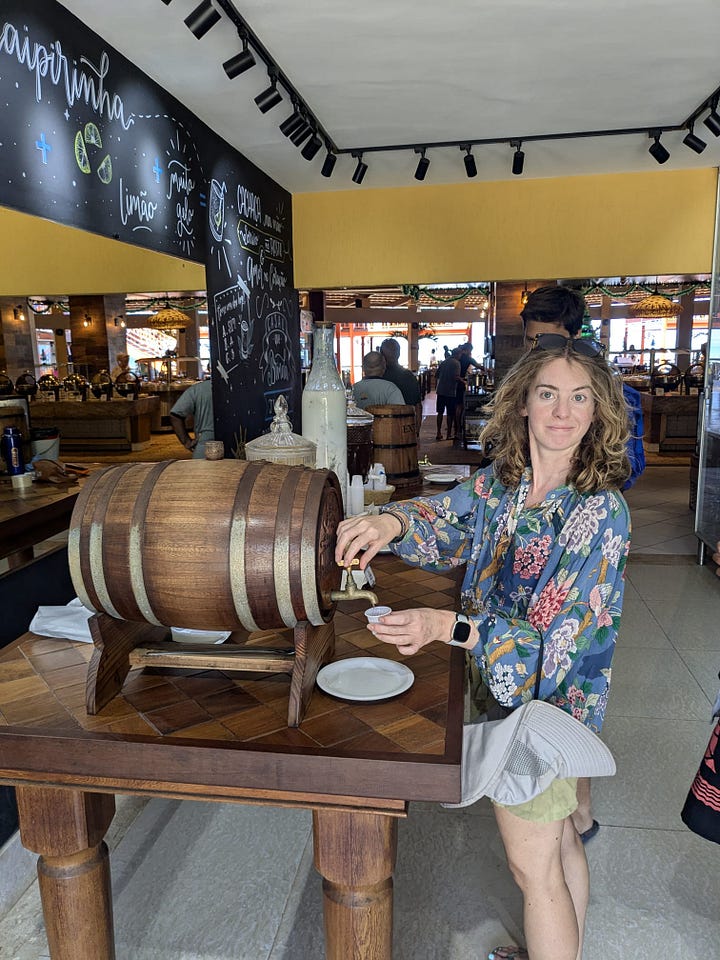
Buffets are great because there's no question of where to go to eat, or debate over who fancies what type of cuisine – there's always plenty of veg for me and plenty of beige for Dave, so everyone’s happy (except maybe his gut). We've been to some proper fancy buffets – one with a separate sushi kitchen; a veg-heavy pescatarian buffet in Brasilia that was run by nutritionists and populated by yummy mummies and the like. But some of the best have been the random roadside service stations we’ve been dumped at for meal breaks during very long bus journeys (a huge plate of freshly grilled meat and pasta for less than £4 each plus drinks; endless tropical salads and three types of feijão beans). The Brazilian buffet is the country's great social leveller, and also the greatest test of my self-restraint.
Getting on for two months into Brazil (three if we include the last trip back in March/April), it was finally time to stop by the capital to see what was what. I hadn't thought much about Brasilia up until this point, perhaps unfairly assuming it would be another dull concrete centre for business and not much else, nowhere near comparable to Rio or Brazil’s other great tourist cities.
Ok, so the assumption wasn't totally wrong, but more fool me for thinking this was any old concrete. Brasilia’s relatively young history is interesting, and the unique building designs mixed with what was a pioneering city plan for the 1960s makes the city a “Mecca for architects” according to my architect friend who would know.
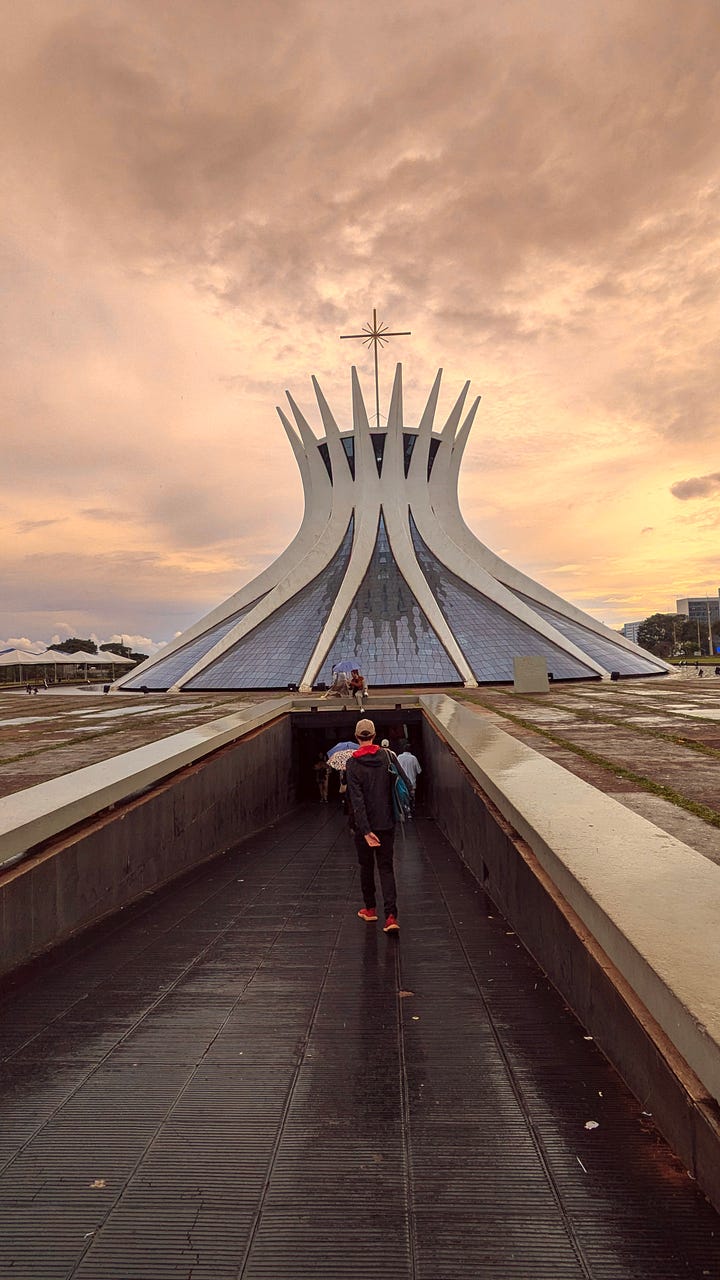

The potted history goes like this: for centuries, Brazil’s capital city was Rio de Janeiro, but the idea to move government business to a new place further inland had been kicking about for almost as long. Tiradentes, a revolutionary leader who fought against the Portuguese occupation of Brazil, put the idea forward for a new capital back in in the 1790s, but then he was hanged. A new plan to move the capital was announced in 1822, and then in 1889, but it wasn’t until the 1950s that a plan was drawn up for modern Brasilia.
The idea was to ease some of the social and economic burden from Rio and pull some of that wealth and industry away from the highly populated coastline and into the pretty vast and underutilised centre. It being the 1950s, everyone agreed that modernist designs made out of concrete were ace, roping in the architect Oscar Niemeyer who was famous for that sort of thing to design a lot of the key civic buildings that form the most recognisable landmarks today.
The city took less than four years to build from scratch, helped by thousands of indigenous labourers no doubt working for minimal pay on the land they’d been forcibly removed from. Like all planned cities, I suppose Brasilia was imagined to be a highly efficient city of the future, with its unique tree-like layout separating the central business district from two long residential arms spanning 11km north and 32km west from the centre. Judging from the bizarre amounts of empty space between sites and largely derelict car parks everywhere, I’m sure the city’s architects imagined that they were building a perfect city for a future where every family would soon have a car of their own to drive to and from their offices in, not realising that by 2024 we’d all be desperately trying to reverse the trend.
It’s a weird place. Dave and I attempted to walk from lunch in the north of town, to the National Congress building and neighbouring sights, and back in a full loop – but it was an unpleasant walk along long Germanic roads reflecting the heat back at us for more than 10 kilometres (we got the bus part of the way back).
Brasilia is also said to be a hub for international cuisine, something we were excited to explore after a few weeks in much more regional places, and after a night spent scoffing cheese and other supermarket-bought picnic food from the comfort of our very nice hotel room watching Love is Blind: Argentina, we planned for a night out-out in the centre of things.
Unfortunately my body had other plans. Have you ever had to lie down and have a little half-sleep on the floor of a shopping centre toilet cubicle? Have you really ever travelled if not? I pride myself on having a strong stomach most of the time, but I've had enough of these episodes through my life to recognise the various stages of decline and recovery that feel so specific to culinary disagreement.
It always starts with a faint dizziness, a bit of a stomach ache (walking around the Catedral Metropolitana Nossa Senhora Aparecida). In the back of your mind you’ll start to think, maybe I should find a bathroom soon, but it comes and goes so you ignore it (in the Museu Nacional da República art gallery). Suddenly it’s urgent and you’ll kick past you from ten minutes ago who didn’t ACT (walking towards the big Torre de TV tower viewpoint, realising you’re not going to make the viewpoint after all). Then you’re retching (trying to find the mulheres in the shopping centre without running), you’re very sure you’re going to pass out (but must hang on until the wretching is complete, dammit), you can no longer feel your hands and feet, your vision goes fizzy and then you’re lying on the floor of the toilet cubicle, thinking of starting a new life there as a cockroach.

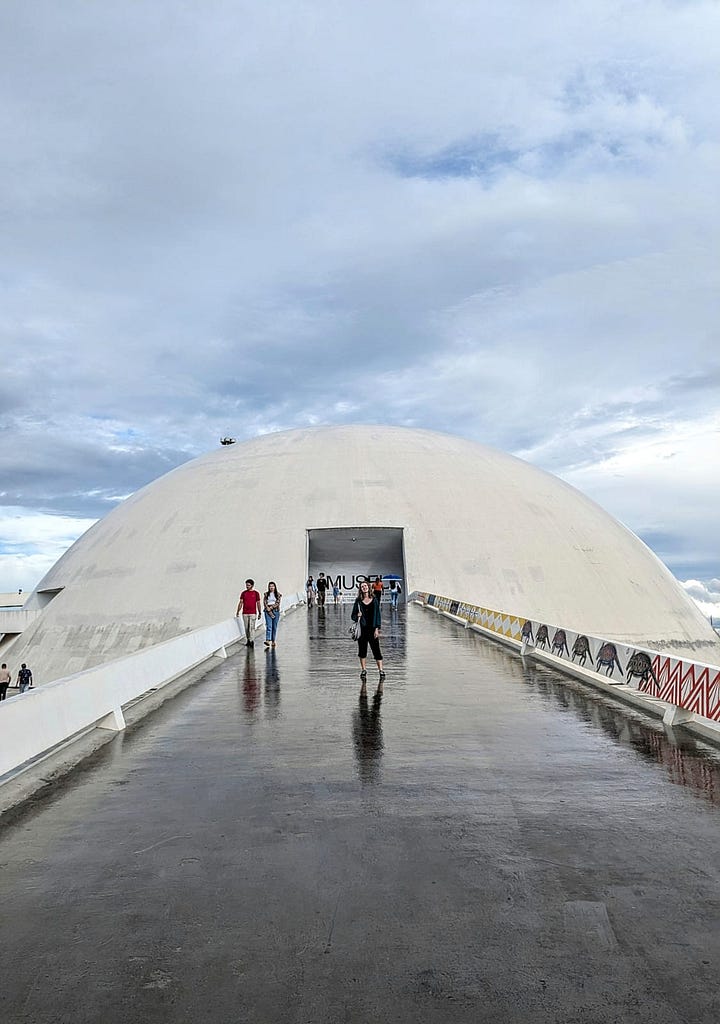
I really don’t know what caused it this time (don’t say the cheeses) but the good thing about – are we calling it food poisoning? Something not quite so dramatic – is that once these stages are complete, the badness recedes just as quickly as it arrived to ruin the day. The floor of a public toilet transforms very quickly from being the most comfortable and safest place in the world to have a nap, to an ordinarily horrying toilet floor, and that’s how you know you’re ready to resume normal life once again.
Even so, we decided to get an Uber home and stay in that night. The irony of dedicating a whole chunk of this newsletter to all-you-can eat buffets and then proceeding to tell you all about how I got sick is not lost on me, but I assure you the culprit was much, much more likely to have been the result of me overdosing on dairy products or picking up some bacteria from the bus. Brazilian buffets are great. Always wash your hands. And if you’re ever passing through Brasilia, there’s plenty to see and eat, I can assure you – we just didn’t quite manage it ourselves.
Travel bits and tips from this week
From Campo Grande in Mato Grosso do Sol, Dave and I took another very long bus (21.5 hours) northwards to Brasilia.
We were cutting through the centre of Brazil to get to the north-east coast, but I like to think we would have made time for Brasilia at some point regardless .
The city is freaking huge and not very pedestrian friendly. We stayed at the Comfort Hotel Taguatinga, although I think the room was privately owned and separate to the hotel itself. This is a quirk we sometimes find through Booking.com and is really just my way of saying we probably paid a lot less than the listed price online.
The hotel was a way out of town, which made it much more affordable and we reasoned that we were near a metro station.
In fact, the bus network is much more reliable and quicker to get around/less time spent waiting than the underground, and you can use contactless bank card payments to get on board – the first time we’ve been able to do this since being in Europe!
The caveat is that the bus routes were numbered by a psychopath and all the buses are called things like 00.003810054 and 5518.0.33 which makes for a real test for the eyes when they’re chugging up the road towards your stop. I’d recommend noting down a few eligible bus numbers beforehand and failing that shouting “CENTRO?!” at passing drivers.
Two out of three evening meals in Brasilia consisted of picnic food in our hotel room, and on the third night Dave set out to source us a Mexican takeaway post-sickness (brave?) at Los Vagabundos (decent for a tex-mex vibe).
We did have a banging buffet lunch at Nattu Restaurante Verde (10/10 recommend) and another day we tried Verte Café Aguas Claras, nearer to our hotel, where I had a sad and overpriced salad and sat with my regrets.
There’s barely anywhere to go for refreshment in the very centre of Brasilia (near the main architectural sites like the cathedral or library, anyway), which feels like another bit of poor planning. But we did get a soft drink at Casa de Chá near the Palácio do Planalto and watched a helicopter try and fail to land outside the palace for about an hour.

